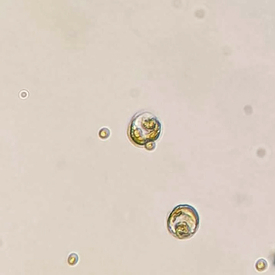News Detail
Natural pesticide for the production of protein-rich microalgae
October 31, 2024 |
For hundreds of years, people have been harvesting wild microscopic algae from lakes as a source of food. The Aztecs, for example, are known to have used fine nets to skim Spirulina from the surface of Lake Texcoco. They dried it and used it in a variety of foods.
To this day, microalgae are popular as a superfood as they contain antioxidants and omega-3 fatty acids, for example. Numerous beneficial health effects are attributed to them. However, the potential of the tiny algae goes far beyond their use in food supplements: microalgae could help to solve some of the most pressing problems of the modern world.
What are microalgae?
Microalgae are microscopically small (many are five microns or less in size), mostly single-celled algae that are invisible to the naked eye. They are a type of phytoplankton, which live suspended in the water column in freshwater and marine systems, where they play an important role in aquatic food webs and in the carbon and nutrient cycle.
Like the larger macroalgae (some of which are also popular as food), microalgae photosynthesise, i.e. they obtain the energy they need by converting sunlight and carbon dioxide into organic carbon compounds and oxygen. There are tens of thousands of species that live in many different, sometimes even extreme, environments – from alkaline salt lakes to the Antarctic.
A natural powerhouse
Their rapid growth rate, their ability to bind carbon dioxide and their high content of proteins, lipids and carbohydrates make microalgae interesting for a whole range of industrial applications, such as the production of bioplastics and biofuels or the storage of carbon dioxide.
Great potential also exists for use as animal feed in agriculture. Compared to soya cultivation, a given amount of protein can be obtained in less time with microalgae – while using less land and less water. Various researchers are currently working on developing this food source, including Agroscope in the Algafeed project. However, there are still challenges making cost-effective production difficult to achieve. These include protecting the cultures from pests, parasites and pathogens.
A recent publication by the aquatic research institute Eawag now offers a new approach here.
Co-cultures for protection against pests
In nature, microalgae form the basis of the aquatic food web because they are eaten by zooplankton (from small animals such as water fleas, to microscopic herbivorous flagellates), which in turn serve as food for larger species such as fish. If the microalgae are cultivated in open-air systems in artificial ponds, which are much more economical than photobioreactors, it is almost impossible to prevent zooplankton from creeping in. To make matters worse, the algae species that are of most economic interest because they grow the fastest (such as Chlorella or Nannochloropsis) are particularly susceptible to pests due to their rather small cell bodies.
Patrick Thomas, a postdoctoral researcher at Eawag, has now been able to show that a co-culture of different microalgae could protect them from being decimated by herbivorous pests.
The flagellate P. malhamensis feeding on the small algae species N. limnetica. The cells of the flagellates are approximately 10 microns in diameter (Photo: Eawag, Patrick Thomas).
Complementary properties
In their study, the researchers led by Thomas cultivated the algae species Nannochloropsis limnetica together with another microalgae, Botryococcus braunii. This species is commercially interesting due to its high content of hydrocarbons that can be used for biofuels, as well as valuable pigment compounds. B. braunii grows very slowly, but it does has another advantage: as the researchers discovered, co-cultures of Nannochloropsis and B. braunii are much more robust against the widespread herbivores Daphnia magna (a water flea about 2 mm in size) and Poterioochromonas malhamensis (a microscopic flagellate) than a monoculture of Nannochloropsis.
Both the biomass and the growth rate of the two algae were increased in the co-culture. Thomas explains: “On the one hand, we attribute this to the fact that B. braunii forms large colonies that are inedible to the herbivores, which can protect Nannochloropsis by reducing the efficiency of herbivores in capturing their algal prey. On the other hand, it is known to excrete compounds like free fatty acids, which are also likely to function as a defence mechanism.”
Positive interactions between the two types of algae could also play a role, adds Thomas. “With a co-culture, the complementary properties of the two algae species can be utilised.” Furthermore, a co-culture also enables the reduced use of pesticides, which have environmental risks and could lead to pesticide resistance in herbivorous pests. “We hope that our results will help to reduce the costs of growing microalgae and thus make large-scale cultivation more economically viable.”
Emphasising that, based on this proof-of-concept study, a great deal of additional research and practical pilot studies are needed to further explore and expand the concept, the researcher says that the next steps could be to transfer the concept to larger scales and to other species and different environments, such as saltwater-based ones.
Cover picture: Microalgae cultivation facility in the Kona region of Hawaii (Photo: Cyanotech Corporation / Charles H. Greene, Celina M. Scott-Buechler, Arjun L.P. Hausner, Zackary I. Johnson, Xin Gen Lei, Mark E. Huntley / Wikimedia).
Original publication
Financing and cooperation
- Eawag
- ETH Zürich



